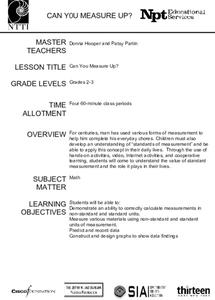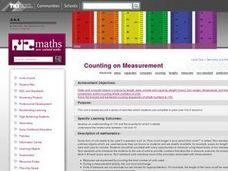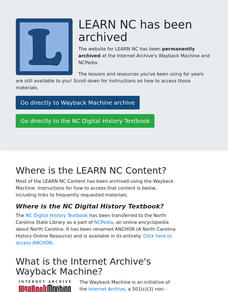Curated OER
Can You Measure Up?
Here is a well-designed lesson on common standards of measurement for your young mathematicians. In it, learners calculate measurements in standard and non-standard units. They make predictions, record data, and construct and design...
Curated OER
Oodles of Noodles
Students investigate non-standard and standard measurement including inches and centimeters. They use different types of noodles as non-standard units of measurement comparing them to inches and centimeters.
Curated OER
A Special Relationship
Learners discover the relationships of the lengths of the sides of right triangles and right triangles using a series of drawings on dot paper. They investigate and solve problems of standard (customary and metric units) and non-standard...
Curated OER
Non-Standard Measurement
Students, using a list made up of things from around the room; estimate the distance of one of the items on the list with one unit, record their prediction, and then actually measure items with non-standard measuring devise.
Curated OER
Counting on Measurement
First graders explore measurement. They measure by counting non-standard units. Students use a variety of non-standard units to predict and measure volume of various containers using rice.
Curated OER
Measure Mania
Students measure their own silhouette using Unifix cubes. They measure a drawing using non-standard measurement. They swap drawings and compare their measurements.
Curated OER
Measuring Up with Apples
Second graders estimate and measure various classroom objects using an apple as their tool for measuring, and record their measurement results on a data worksheet.
Curated OER
Bearly There
First graders read "How Long Is A Foot?" together and use paper clips, teddy bears, crayons and other non-standard units to measure items. They compare the items measured and order them from longest to shortest.







